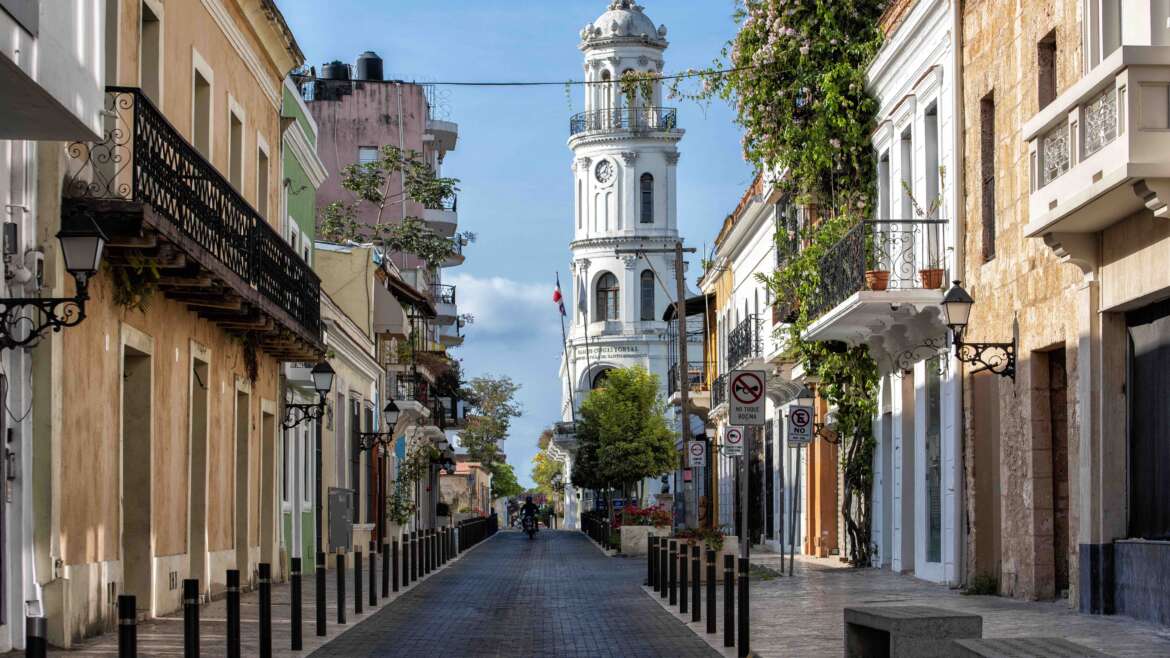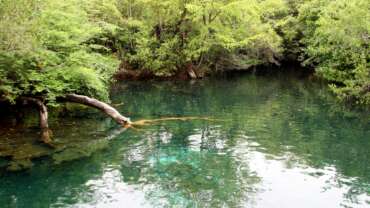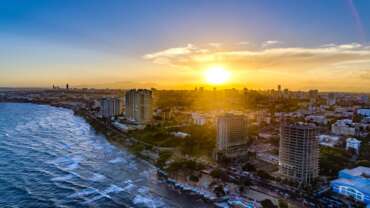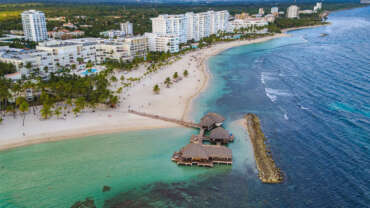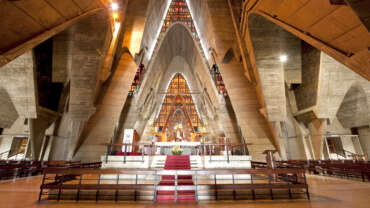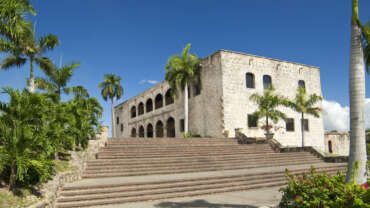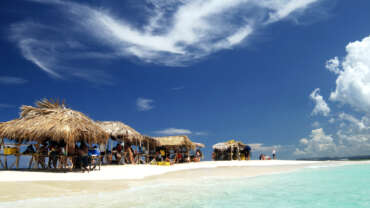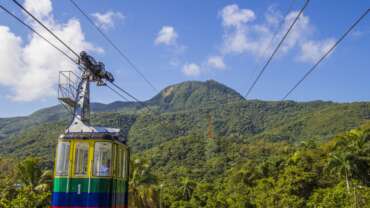Destinations in Dominican Republic
SANTO DOMINGO
The Dominican Republic’s capital city, Santo Domingo is also the most modern and dynamic metropolis in the Caribbean. La Capital—as it is affectionately called—epitomizes the pulse of Dominican culture, where the old and the new converge seamlessly from centuries old architecture and history, to large shopping malls, art galleries, an electric nightlife, and a booming gastronomy scene.
Exploring the Colonial City—the first European settlement of the Americas and a designated UNESCO World Heritage Site in 1990—is a recommended experience for all travelers. This historic neighborhood consists of a pedestrian-friendly maze of narrow streets brimming with 16th to early 20th century architectural wonders. They lead toward colonial buildings turned museums, shops, hotels, restaurants, and sidewalk cafés. Hop on the Chu Chu Colonial train for a 45-minute tour of the area, hire a guide who will walk you down the first paved road of the Americas while sharing tales, or rent a bike and meander on your own. For a nature break, picnic on the lawns of the National Botanical Garden, the largest in the Caribbean, or stroll down the Malecón at sunset for sea views, roadside snacks, and people watching.
Beyond the sights, a cultural experience is never far in Santo Domingo’s eclectic neighborhoods. Shop at one of the exclusive malls or at an artisan gallery in the Colonial City—get a linen chacabana shirt, a leather handbag, or a ceramic faceless doll. Dine in style at brand hotels citywide where renowned chefs create twists on Dominican and international cuisine. Relax with a Dominican puro at one of the open terrace-bistros overlooking Plaza de España, or mingle at rooftop lounges on Gustavo Mejía Ricart Avenue. And when you’re ready for the beach, a forty-minute ride lands you onto Boca Chica’s soft, white sands facing a crystal clear Caribbean Sea, where seafood restaurants and entertainment await. Whichever your preferred beat, Santo Domingo has it.
Las Americas International Airport (SDQ) is the main port of entry, half an hour east of the city center, while the cruise ship port sits just 10 minutes from the Colonial City.
PUNTA CANA
Blessed with one of the Caribbean region’s longest white sand coastlines–a whopping 48 kilometers (30 miles), punctuated with sky-reaching coconut palms–Punta Cana is the land of rest and relaxation by the sea. Here, where the Atlantic meets the Caribbean, from the northern tip at Uvero Alto to the southern at Cap Cana, all-inclusive resorts and boutique hideaways offer all the whims and comforts of modern beachfront living. Families enjoy miniature entertainment centers and water parks for children, while couples-only enclaves boast dream wedding locations, with secluded beachside lodging for an ultra-romantic stay. But it’s not only about fun in the sun, soft sand brushing against your toes, and iridescent, clear water to swim in, go fishing, or dive for underwater life and shipwrecks. Punta Cana is also a golfer’s destination, with 10 courses located all along the strip, a seaside escape with luxurious marinas and fine dining, and a wellness corner home to the country’s top spas, including the only Six Senses in the Caribbean.
Wherever you settle on this brilliant white Punta Cana coastline–counting 11 Blue Flag certified beaches in its inventory–go beach hopping to enjoy its full splendor. From scenic surf-hub Macao and Bávaro’s hipster beaches Corales and Cortecito–lined with shops, water sports, and beachfront bars–to secluded Juanillo, among others.
Spend a day away from the sand and you’ll find a myriad of inland adventures. Cool off in fresh water azure cenotes and lagoons tucked inside forests at Ojos Indígenas and Scape Park, where the family’s tweens can also enjoy ziplines and caving expeditions. Explore the lush Dominican countryside on an off-road safari, tumbling past roadside meat shops, and sugar cane plantations. Along the way, visit the country’s top pilgrimage site at the Basílica Nuestra Señora de la Altagracia, and feel the DR’s deep spiritual roots.
If daytime activities are abundant, nights are no less vibrant. The young at heart can dance the evening away until their feet tire at the DR’s modern nightclubs, while classy evenings under the stars await at marinas and seaside lounges, with cocktails, bites, and hand-rolled cigars.
Punta Cana is the quintessential water, sun, and sand escape.
Punta Cana International Airport (PUJ) is the most-connected airport in the Caribbean and Central America, receiving flights from 26 countries and up to two million passengers a year. Since 2017, the area is also a cruise ship destination thanks to Marina Cap Cana, which now welcomes small luxury cruise ships. By land, the Oscar de la Renta highway, also known as Autopista del Coral, puts visitors less than an hour away from La Romana’s beaches and multiple attractions, and just two and a half hours from Santo Domingo and its Colonial City.
SAMANA
Jutting out of the DR’s northeastern shore and basking in the ocean, the nature haven that is the Samaná Peninsula is as coveted today as it was in the 16th century. Pirates hid in its lush, palm-filled forests, isolated beaches, and hidden caves, while European and Haitian troops competed over its deep water, protected bay. Today, Samaná–often abbreviated to refer to the entire peninsula–is well connected by land and air, yet it remains the DR’s secluded, paradisiacal escape of wild beaches, coconut plantations, and rainforests. Its rolling mountains and valleys form the crystalline rivers that feed into the Atlantic, as they cascade toward brilliant white sand beaches stretching hundreds of kilometers all around the peninsula’s rocky coastline. It’s as if the approximately 2,500 humpback whales that visit Samaná Bay every year appreciate this natural splendor as much as visitors do. The giant mammals return every year to this special corner of the DR to mate, birth, and bask in this glorious tropical scenery. Aside from seasonal whale watching boat excursions in Samaná’s scenic bay, more ecotourism adventures are a stone’s throw away: body-boarding and kitesurfing in Las Terrenas; trekking, birding, and caving in Los Haitises National Park; canyoning or horseback riding to reach El Limón waterfall; and boat-hopping to magnificent white sand beaches at the base of 90-meter (300-feet) cliffs, or to offshore Cayo Levantado island.
Samaná is also an independent traveler’s dream. Thousands of Europeans arrived as tourists and became residents, setting up businesses that give the area its unique cosmopolitan vibe. In Las Terrenas, French cafés and quaint guesthouses give way to Euro-chic boutiques, bistros, and beachfront lounges. But the peninsula retains its diverse cultural heritage. Croissants aside, you’ll find a cuisine rich in coconut flavors and seafood–an influence of early Canary Islands settlers, and descendants of 18th century African American immigrants who continue to thrive here. In Las Galeras, the fishing village life remains firm despite the large daytime tourist crowds who flock here to reach the renowned Playa Rincón.
Wherever you decide to stay on the peninsula, perched in treehouses in El Valle, tucked away in an eco-cabin in Las Galeras, or nestled in a beachfront suite, on glorious golden sands of Cosón: prepare for days surrounded by one of the Dominican Republic’s most magnificent beaches and rainforest escapes, where the echoes of merengue and bachata are never far away.
El Catey International Airport (AZS) is the gateway to the Samaná Peninsula. Cruises dock in Samaná in the winter season, near Cayo Levantado and the Bay of Samaná. Sailing enthusiasts will find full docking facilities and slips of up to 150 feet LOA at Puerto Bahía Marina, on the north end of Samaná Bay. By land, modern highways connect the peninsula to major points, including the Santo Domingo-Samaná Highway, or Route 7, and the Boulevard Turístico del Atlántico towards Las Terrenas, offering breathtaking, winding coastal views over the Bay of Cosón.
PUERTO PLATA
The birthplace of tourism in the Dominican Republic, Puerto Plata continues to pack a mighty punch. Its spectacular, sprawling landscape combines sea, mountains, lush valleys, rivers, and a multitude of beaches. Its fertile soil grows cacao and coffee trees, while underneath rests the world’s clearest amber.
Savvy explorer Christopher Columbus knew there was much to discover on this northern Atlantic coastline–eventually finding gold deposits–when he glimpsed it from his ship in 1492. Drawn by the sight of clouds shimmering over Mount Isabel de Torres and illuminating Puerto Plata’s vast blue shoreline, he named the area the “Silver Port” and settled at La Isabela with a mixed community of Tainos–original inhabitants of the area–and Spaniards, built the first church and his first home in the Americas. You can follow Columbus’s trail and tour these archeological ruins, now part of a national park.
Puerto Plata’s natural bounty continues to astound those who lay eyes on La Novia del Atlántico, or as locals call it, the Atlantic’s Darling. A bird’s eye view from the cable car–the only one in the Caribbean, taking passengers to Mount Isabel de Torres and its lush botanical gardens–reveals part of an Atlantic coastline with more than 100 kilometers (62 miles) of beaches gracing multiple coastal villages, inland farming communities replete with rivers and falls, and hotels of all sizes to suit all tastes. To boot, Puerto Plata is home to colonial vestiges, including the largest collection of preserved 19th century Victorian-style houses in the Caribbean, the oldest amber fossils in the world on display at the Amber Museum, and one of the first colonial period fortresses in the region at Fortaleza San Felipe, dating back to 1577.
East and west along Puerto Plata’s coastline, steady trade winds, river systems, the vast Cordillera Septentrional mountain range and the Atlantic Ocean conspire to create a world of outdoor adventure, including beach towns renowned for water sports. Less than half an hour from the city, Sosúa was first settled by Jewish immigrants who fled Nazi Germany, boasting beautiful beaches where expats and locals coexist, and rich underwater sites. Nearby Cabarete is a world famous hub for windsurfing, surfing, and kiteboarding, and a favorite cosmopolitan hideout of snowbirds. Playa Dorada is for those who want to relax in style on golden stretches, with seaside activities near the city, from canyoning at 27 Charcos of Damajagua waterfalls to snorkeling at Cayo Arena, and relaxing at Ocean World Marina.
Nature aside, Puerto Plata’s multitude of vibrant villages translates into a host of cultural experiences. Home of community tourism, here is where you can hike family-owned cacao or coffee plantations, learn how to play and dance merengue from a family of musicians, or immerse in Dominican pelota at the Bartolo Colón stadium and museum. Along the way are a multitude of culinary experiences, from roadside snacks to beachside seafood, and gourmet international restaurants.
Puerto Plata’s main points of entry include the Gregorio Luperón International Airport (POP), located 15 minutes from the city center and Playa Dorada or Costa Dorada hotels, and the Amber Cove Cruise Center in Maimón.
LA ROMANA
Overflowing in natural riches—from a poster-worthy Caribbean coastline to world-class golf courses—La Romana is one of the country’s top destination picks. Fields of sugar cane lead to continuous white sand beaches from Dominicus to Bayahíbe. Cave-riddled forests inside Cotubanamá National Park are home to fresh water springs and Taino rock art. Offshore, the islands of Saona, Catalina, and Catalinita are lined with turtle nesting stretches facing pristine coral reefs, while shipwrecks teeming with marine life rest at shallow and extreme depths.
The largest sugar cane mill in the Americas was once headquartered in La Romana, until its owners diversified and ventured into tourism by opening the luxurious Casa de Campo Resort in 1974, a celebrity favorite and renowned destination for its award-winning Pete Dye golf courses. The adjacent 16th century Altos de Chavón followed—a stunning replica of a Mediterranean village towering over the Chavón River, and bustling with entertainment—including an outdoor Grecian amphitheater where Grammy-winning artists perform every year.
While visitors flock to La Romana for a luxurious seaside lifestyle of chasing tail, scuba diving, fine dining, and shopping, its fishing village charms along Bayahíbe and Dominicus win many more over. La Romana is the gateway to Saona and Catalina Islands, which are part of the Cotubanamá National Park, and the most visited natural attractions in the country.
One wouldn’t expect any less from the only location in the DR and the world where the rare Bayahíbe Rose originates—a soft pink-colored cactus-shrub named National Flower of the DR in 2011 and featured on the Dominican currency.
The main ports of entry to La Romana and Bayahíbe are La Romana International Airport (LRM) and Casa de Campo Tourist Port.
JARABACOA
Perched at an altitude of 529 meters (1,736 feet), this scenic mountain resort town is a favorite escape of Santiago and Santo Domingo city dwellers. They flock here in search of cool temperatures, fresh rivers, and sweeping green landscapes flanked by dense pine forests and coffee-producing mountains. An eco-tourism hub easily accessed via modern highways, Jarabacoa–meaning “place of waters” in Taino–boasts a variety of charming accommodations, from riverside ranches and eco-lodges to luxury vacation villas perched in the mountains.
Most adventurous travelers who reach this unique side of the country arrive on a quest to conquer the tallest peak in the Caribbean: Pico Duarte, standing 3,087 meters (10,125 feet) inside the Armando Bermúdez and José del Carmen Ramírez national parks, reigning over the Cordillera Central mountain range. From this mighty summit flows the Río Yaque del Norte, the longest river in the DR, running through the heart of this Cibao region like its lifeline. Along with at least six additional rivers sourced here, including their tributaries, this is a world of waterfalls and outdoor water adventures: go river rafting, tubing, canyoning and rappelling down Salto Baiguate, hiking to the Salto de Jimenoa falls, or swimming at La Cortina and La Confluencia, two recreational parks fed by fresh pools.
On land, horseback riding is part and parcel of Jarabacoan culture. You haven’t quite felt the magic of this valley-filled town until you’ve been galloping on horseback or riding freely on a scooter along verdant fields, fragrant with cilantro and tayota, past cows grazing along riverbanks and under mango trees, and wooden cabins tucked near mountain tops. Feeling the pulse of Jarabacoa also means exploring its surrounding villages in La Ciénaga and Manabao–preferably by mountain bike–offering even more breathtaking mountain views along narrow, winding roads, and coffee farms that this region is known for. You could also choose to get a spectacular bird’s-eye view of the area by paragliding in tandem over Jarabacoa’s peaks, valleys, and falls.
Downtown Jarabacoa, easily explored on foot, bustles with shoppers, diners, vendors, and a hint of nightlife after sundown. Because it’s as much a vacation escape for Dominicans as it is for visitors, Jarabacoa is blessed with affordably priced daily amenities, from well-stocked supermarkets to a bevvy of dining options. Snack on a delicious steak roadside at one of the area’s famous parilladas or grills or dine under the stars with panoramic views. On the outskirts of town, Café de Monte Alto factory produces the city’s prized blend–stop in for a coffee-making tour and plenty of tastings that are sure to keep you warm in this “city of eternal spring.”
To boot, Jarabacoa is the only town in the country with an annual flower festival, held in June, celebrating the mountain life culture with horseback parades, flower contests, and folkloric dancing. What’s not to love?
The Cibao International Airport (STI), located in Santiago, approximately an hour north from Jarabacoa and a half hour from La Vega city, is the closest gateway.
CONSTANZA
Boasting an average elevation of 1,200 meters (4,000 feet), Constanza is the highest altitude town in the Caribbean region. With those impressive heights come cool temperatures, rolling valleys blanketed in thick pine trees, cabins fitted with chimneys for the single digit night temperatures, and an agricultural landscape that reveals a surprising departure from the beach. Breadbasket of the country, Constanza’s vast fields of vegetables–potatoes, cabbage, corn, and carrots, among others–flowers, and even strawberries can be seen while driving around the province. Its mountainside villages boast magical views over these fields, earning Constanza nicknames like “the Switzerland of the Caribbean” and “Valle Encantado” or the Enchanted Valley.
Bordered by four large national parks, including two scientific reserves, this geographic center of the Dominican Republic is blessed with nature–from freshly harvested foods to fresh river sources, and multiple types of forests. Valle Nuevo National Park–the highest plateau in the region at approximately 1,900-2,100 meters (6,500-7,000 feet)–is home to major rivers supplying the country, not to mention ideal hiking trails amid cloud, criollo pine, and fern tree forests as well as highland plains. Over 70 species of birds thrive there, including the endangered golden swallow, and you’ll find plenty of reptiles, amphibians, and over 500 species of plants. At the Ébano Verde Scientific Reserve, chilly but fresh pools await amid an environment of precious woods and over 80 species of orchids, giant tree frogs, and lizards.
On the weekends, Constanza’s small town center bustles with bars, gourmet restaurants–enjoy fresh vegetable pizzas or strawberry shakes–and a central park that fills up with weekend visitors from Jarabacoa, Santo Domingo, and Santiago.
Temperatures year round average between 5°C-25°C (41°F-77°F). From December to March, the air gets chillier, with temperatures dropping into single digits at night, yet warming up nicely during the days. Summertime temperatures are pleasant and mid-day hours are not too warm. Pick a local guesthouse or ecolodge, rent a car, and begin your exploration. Tour farms where you can purchase homemade fruit marmalades. Go birding at Valle Nuevo National Park, or hiking in the Tetero Valley. Hop on a horseback ride to El Divino Niño–Constanza’s beautiful version of a Christ the Redeemer statue. Mountain bike your way around farm roads. Venture to the highest altitude Aguas Blancas waterfall. Along the way, stand on any hilltop in Constanza to take in the magnificent mountain and farm scenery. You might just feel like you’re hearing the sound of music.
The Cibao International Airport (STI) in Santiago is the closest gateway to Constanza, located approximately two hours north.
SANTIAGO
Santiago de los Caballeros–named after the 30 Spanish aristocrats who followed Columbus and settled here in 1495–was the country’s first capital before it suffered an earthquake in 1562. Today, the Dominican Republic’s second largest city–affectionately dubbed “Ciudad Corazón” or the city in the heart of the Cibao Valley–is a modern and cosmopolitan center thriving in commerce, finance, education, and services, and pulsating with culture.
Towering over its sprawling urban streets, the Monumento a Los Héroes de la Restauración–affectionately called El Monumento–is the city’s chief landmark and social hub, where residents and visitors gather on its lawns, but also serves as a constant reminder of the men who regained the DR’s independence from Spain in 1865. Looming in the distance is the Cordillera Central mountain range, replete with hiking adventures. History, arts, and culture are never far in Santiago–Centro Cultural León offers a comprehensive display of the country’s rich heritage–and are part and parcel of this significant region as birthplace of the Mirabal Sisters, as well as several Dominican presidents. Home to universities, the area also brims with a dynamic population of millenials, amid professionals, all of whom enjoy the city’s vibrant entertainment and nightlife, boasting over 100 discos, bars, and lounges within the downtown area.
Despite the big city life, traditions run deep. Baseball passion thrives, as Santiago is home to the popular Aguilas Cibaeñas team, winners of three Caribbean Series and 22 national titles since 1952. In the city’s surrounding areas are some of the most talented artisans and painters in the DR, while Santiago Carnival ranks among the most revered in the country, with the most bejeweled handmade devil costumes after La Vega’s. To boot, nature has blessed the province with fertile soils that grow the world’s finest tobacco, home to 90 percent of the largest cigar plantations and factories and earning Santiago the nickname “Cigar Country.” Puro aficionados will also find all the premium brand factories near the city center at Tamboril, offering free daily tours and exclusive shopping opportunities.
Cultured, innovative, and fast-paced: that’s Santiago. Yet minutes outside city limits, the peaceful sight of mountains and cool air whisk you away from the hustle and bustle, plunging you into the stunning Cibao heartland.
The Cibao International Airport (STI) is conveniently located a half-hour from the city center.
MONTECRISTI
The jewel of the northwest, the border province of Montecristi presents a wild and striking landscape ripe for off-the-beaten-track adventures. Rice plantations, banana fields, goats and giant cacti stand sentry roadside, leading towards salt ponds and onto limestone cliffs hugging a wave-rich Atlantic Ocean. Around this part desert and part Mediterranean-like scenery, thick mangrove tunnels give way to fresh lagoons, while offshore cayes teem with migratory birds, and offer secluded white sand beaches.
Unpretentious, the town of San Fernando de Montecristi–founded by Nicolás de Ovando in 1501 and named after King Ferdinand of Spain–reveals a rich and inspiring legacy. It’s where Cuban José Martí and Dominican General Máximo Gómez planned for Cuba’s independence from Spain–you can view key documents on display at the Museo Máximo Gómez. Juan Isidro Jiménez, President of the Dominican Republic from 1899 to 1911, hailed from Montecristi, while immigrants flocked from Europe, the United States, and South America during this period to help export the region’s wood and agricultural products. The town was transformed into a major trading port. Few also know that Montecristi is where the Dominican Republic’s first aqueduct, railroad, and telephones were installed.
Sunsets grace the town’s small but beautiful boardwalk and beach, with multiple surrounding hotels and restaurants serving the area’s traditional spicy goat specialty. From your seafront table and from any point in town are unmistakable views of El Morro–the iconic mesa looming over Montecristi like its very own “Table Mountain,” at the foot of which sits a spectacular blond beach. Those who venture off the sand onto the Atlantic Ocean can kitesurf to their heart’s content, or go underwater to explore the coral barrier reef running parallel to El Morro and stretching all the way to Punta Rucia. It’s the largest and healthiest reef in the DR. In the distance, across the bay of Montecristi, the best snorkeling and diving adventures in the country lie off Cayo Siete Hermanos, a series of seven cayes doubling as a primary nesting site of brown boobies and migratory birds.
Last but not least, you’ll want to look out for shipwrecks–Montecristi’s waters are known as the “ship graveyard of the Caribbean,” with over 450 sunken galleons dating back to Columbus’s days, many of which await discovery and study from marine archeologists.
With a wild terrain that leads to inevitable outdoor surprises, Montecristi is where you can live out your own Pirates of the Caribbean adventure.
The main gateway to Montecristi is the Cibao International Airport (STI) in Santiago, followed by the Gregorio Luperón International Airport (POP), in Puerto Plata.
JUAN DOLIO
Located an hour east of the capital city of Santo Domingo, and closer still to Las Américas International Airport (SDQ), the cosmopolitan beach town of Juan Dolio offers an easy and tranquil tropical escape near the capital city. A favorite of well-heeled urbanites who flock here on weekends, Juan Dolio’s 10-kilometer (six-mile) long, spacious and sparkling white sand beach is dotted with hotels, dive shops, restaurants, and bars, as well as a variety of vacation homes, upscale residential communities, and newly built condominiums.
Beyond days spent on Juan Dolio’s stunning beach, a host of nearby attractions awaits. The adjacent Guayacanes fishing village, with its canoe-punctuated white sand beach, offers a perfect day trip filled with local culture, while Playa Caribe’s azure waves attract surfers. Golfers will find their bliss at Juan Dolio’s Guavaberry and Los Marlins courses, teeing along verdant views, while hikers can head to the “cave of wonders,” revealing a wealth of Taino rock art.
Juan Dolio is also an ideal base for day trips to Santo Domingo, San Pedro de Macorís, or La Romana. These activity and shopping-packed cities are located within an hour’s reach heading east or west.
Las Américas International Airport (SDQ) is the ideal port of entry for overnight stays in Juan Dolio.
BARAHONA
The deep southwest of the Dominican Republic, dubbed “El Sur Profundo,” is geographically removed from the country’s primary tourist destinations – but those who get closer will find that remoteness has its perks: the most biodiverse reserve and parks in the country, surfing beaches drawing athletes in search of their next break, fresh water cascades turned natural recreational swimming parks, birding havens tucked amid mountain ranges, and plantations producing some of the country’s finest coffee. It’s no wonder this region has also earned the nickname “Pearl of the South” or “La Perla del Sur”.
Past Barahona’s eclectic local pulse, the province itself and its inland surrounding areas of Bahoruco and Independencia plunge you into a scenery of fishing villages with sand dotted by canoes, and sights of mountain ranges that seem to come down from the sky and fall into the iridescent turquoise Caribbean Sea as you drive along the scenic Barahona-Enriquillo Coastal Highway. Covering a surface of around 7,700 square kilometers (3,000 square miles), the Barahona province is a nature and wildlife-watching haven, with multiple attractions that could keep you occupied for days.
The Sierra de Bahoruco National Park, which makes up part of the country’s sole UNESCO Biosphere Reserve, reveals multiple ecosystems that range from dry forests to cloud–rising over 2,000 meters (7,500 feet) and where unique species make their home. These include at least 180 species of orchids, of which 32 are endemic, rhinoceros iguanas, and over 100 species of birds along marked trails. Complementing this wilderness are rivers cascading down to meet pebble stone beaches, towering bluffs with a coastal scenery unlike anywhere else in the DR, and caves tucked in thick fern forests leading you toward refreshing swims in blue sinkholes while hearing mystical tales.
When you’re not mountain biking, hiking in forests or chasing after gemstones at the larimar mines, catch an artisan marmalade making session with the local cooperative in La Ciénaga, or just relax at one of the village’s local bars.
Like a paint palette at your disposal, Barahona’s widespread outdoors and atypical sights allow for picking and blending your choice of scenery and adventures.
The best entry point for overnight stays in Barahona is Las Américas International Airport (SDQ) in the capital city of Santo Domingo, located approximately three hours west.
PEDERNALES
Tucked in the southwestern most corner of the Dominican Republic, bordering Haiti, the Pedernales province is as remote as it gets. Yet this distant, desert-like coastal landscape beckons the ultimate outdoor explorer–a place where giant cacti line the roads with intermittent views of iridescent turquoise shores, where cows and iguanas are a frequent sight, and where naturalists will find the country’s most significant reserves.
The majority of visitors head to Pedernales to reach Bahía de Las Águilas, the crown jewel of Dominican beaches, sitting below breathtaking karst cliffs and untouched since Pre-Columbian times. But those who stay overnight will find a province boasting some of the most unique geographical features and protected natural sights in the country. Parks, lagoons, and lakes that host endemic, endangered reptiles, birds, and wild flora. Ancient Taino caverns that reveal freshwater sinkholes, and rock art few have explored. And the Jaragua National Park, a jewel in the DR’s nature crown, part of a designated UNESCO Biosphere Reserve, that is home to 400 species of flora, 130 species of birds–look for flamingos at Laguna de Oviedo–an abundant marine life with turtles nesting on its beaches, and sharks swimming off the islands of Beata and Alto Velo. You’ll find a haven of reptiles as well, including the Hispaniolan solenodon, and the Hispaniolan hutia. Nearby, American crocodiles breed and bask in hypersaline waters at Lago Enriquillo, the Caribbean’s largest lake, sitting 43 meters (140 feet) below sea level.
Head off the beach and forests, and swim in river fed pools amid caverns. Or drive up into the cool mountains at 1,300 meters (4,265 feet) above sea level, and witness rare Caribbean phenomena like the geological depression at Hoyo de Pelempito.
Pedernales’ attractions are often included in tours of the Barahona province, located approximately two hours away (135 kilometers or 84 miles). But you can escape the madding crowds and overnight near the country’s most pristine beach if you choose, and take in this nature province’s wild surroundings.
Pedernales’ best entry point is Las Américas International Airport (SDQ), located approximately four and a half hours west.
LA VEGA
La Vega has gained its place in the book of tourism for the colors and sights of its Sunday carnivals in February. It is the capital of the province where the mountain vacation destinations of Jarabacoa and Constanza are located. It is also center for the veneration of the patron virgin of the Dominican Republic, Our Lady of Mercedes. But before you head into the surrounding mountains, take time to get to experience this hospitable city.
The Cibao International Airport (STI) is the closest airport for those headed to La Vega.
BOCA CHICA
On weekends Boca Chica caters to Santo Domingo city residents who come for the shallow turquoise-colored waters. Boca Chica is the place to eat fried fish or seafood with a view at one of the many beachside restaurants. On weekdays, tourists can practically have the beach and town to themselves. There are three beach areas: Boca Chica (swimming, dining and night life), Andrés (sailors and sport fishers), La Caleta (divers).
Over the years singles tourism has settled in, but Boca Chica’s three all-inclusive resorts are heavily into conference and sports tourism. Tourists staying there get to enjoy a beach, proximity to Las Americas International Airport, are half an hour from the Colonial City, and are close enough to good golfing in Juan Dolio and La Romana.
Boca Chica is conveniently close to the Mirador del Este park sports venues, diving at La Caleta Underwater Park, sailing and fishing installations and the beach volleyball courts.
Boca Chica is a 10-minute drive from the Las Americas International Airport (SDQ).
BONAO
Midway between Santiago and Santo Domingo, Bonao is often considered just a stop for a meal but its natural beauty high in the hills and the local art make it more of a destination. The Blanco River ecotouristic trails and Jima waterfalls are easy to access. Its outstanding Cándido Bidó and Tiburcio museums are open all year round and visiting the Bonao Carnival during the month of February is particularly enticing.



